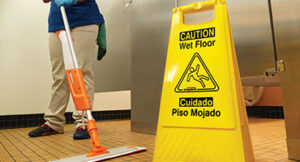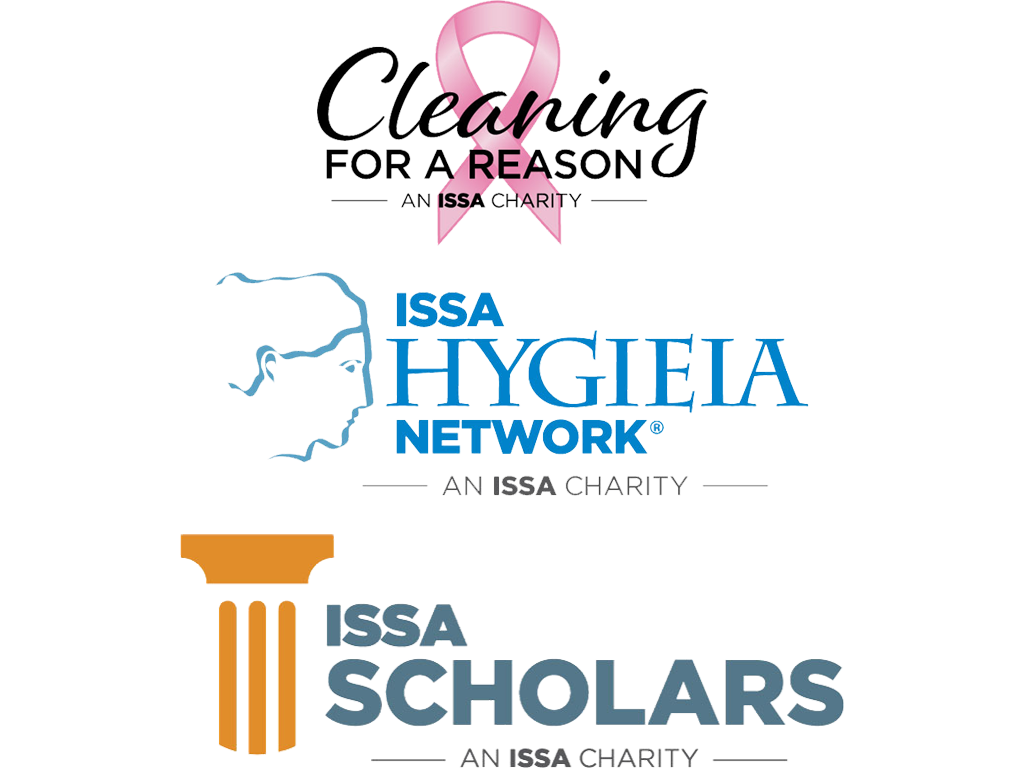Articles
All Signs Point to Safety
Categories: Cleaning Applications, Regulatory
By Vicky Adams | May 17, 2018 << Back to Articles
Accessible by: anyone
The professional cleaning industry talks safety, but we don’t always walk safety—especially when it comes to the proper use of safety signs. For some distributors, it’s a simple dollars-and-cents issue. There’s a lot more money to be made selling floor machines, for instance, than selling danger signs that indicate a floor might be slippery.
Building service contractors also might forget the importance of installing safety signs, especially if they believe they are the only ones in a facility. The first problem with this is that the 9-to-5 workday is disappearing in the 21st-century office space. Now, building occupants go into work just about any time of the day, any day of the week.
Another reason not using proper safety signage is a bad policy is because some of the most serious slip-and-fall accidents have occurred when cleaning workers themselves forgot or did not know that a carpet had just been extracted or a floor refinished.
Not only is the use of safety signs important for both building users and cleaning professionals, it’s also the law. The U.S. Occupational Safety and Health Administration’s (OSHA) 1910.145 specifications require that safety signs be installed wherever there are specific hazards that without identification could result in an accident or injury. OSHA also has regulations regarding danger signs. For instance:
- A sign that indicates danger must be red, white, and black
- A caution sign must be in yellow, black, and white
- Any safety instructions—typical guidelines or suggestions—are to be in green and white.
According to OSHA regulations, the wording should be easy to read and contain specific information that is easily understood. The latest Globally Harmonized System of Classification and Labeling of Chemicals (GHS) revisions to the OSHA Hazard Communication Standard updated the presentation of specific information to include pictograms that convey warning and safety information no matter the language of the user. The use of pictograms also is required to comply with American National Standards Institute (ANSI) Standard Z535.
While the GHS revisions put greater emphasis on pictograms to convey a message, the words used on safety signs are still important and refer to different potential hazards. For example, a sign that indicates caution might not be the appropriate sign to install in a situation where there is considerable risk of injury or even death. In its place, a more appropriate sign would read “danger.”
Here are the different situations in which a safety sign should be installed, for instance, over a hard-surface or carpeted floor dictated by the potential hazard:
- Hazard may be present: If a potential hazard that could lead to an accident or injury may be present, such as lightbulbs being changed in an interior walkway, the appropriate sign to use should read “caution.” Although it is doubtful anything would happen that could result in an accident, it still could happen, calling for the use of a caution sign.
- Hazard possible but not probable: A more urgent message would indicate the possibility, but not necessarily the probability, of an injury or death. In such situations, a “warning” sign should be installed. A warning sign often is also posted when there is a biohazard present, like in a storage room.
- Hazard high probability: This is the most urgent of the three types of safety signs, and the word “danger” will be included. It is doubtful a cleaning contractor would ever install such a sign if performing typical cleaning tasks; this sign should be used only in extreme situations in which individuals could be harmed. It is not to be used if the hazard involves only property damage.
Other words used on safety signs in the professional cleaning industry include “notice,” which might be posted outside a facility, for instance, to tell building users that floor or carpet cleaning work is being performed inside. “Emergency” is used to indicate procedural instructions, such as an emergency exit or emergency eye bath.
Replacing Safety Signs
The new GHS labeling revisions have specific dates by which safety labels must be placed on cleaning solutions, but similar requirements do not apply to safety signs. In most cases, signs are replaced when they are no longer readable, damaged, or their appearance has degraded.
When it is time to replace older safety signs, always select those in compliance with the latest GHS labeling standards. Also, when selecting new safety signs, look for the following:
- Signs should be highly visible; many green and yellow signs are fluorescent, which enhances their visibility.
- They should be written in both English and Spanish (if used in North America).
- They should be durable and stackable.
- The reason the sign is posted or the potential risk—for example wet floor—should be indicated.
- Signs should have UV protection so they can be used outside.
- They should be three-sided and visible from approximately 35 feet.
- They should be 25 to 35 inches tall.
Whether using new or older safety signs, it is important to place them several feet before or ahead of the work or risk area. Signs also should outline this area, so building users know exactly where they can and cannot traverse. All safety signs should be removed as soon as the risk has been eliminated. If not removed, the sign will lose its impact and meaning; building occupants will come to ignore future safety signs, which is one of the worst things that can happen.
GHS is a major step forward in helping our industry “walk the talk” when it comes to safety, whether it involves chemicals or safety signs. Cleaning contractors and distributors should never underestimate the importance of these signs; their purpose is the same as that of the entire professional cleaning industry, and that is to help keep building users healthy.
About the Author.
Vicky Adams is category manager for safety, gloves, and food service products for Impact Products LLC. She can be reached through her company website at www.impact-products.com.


